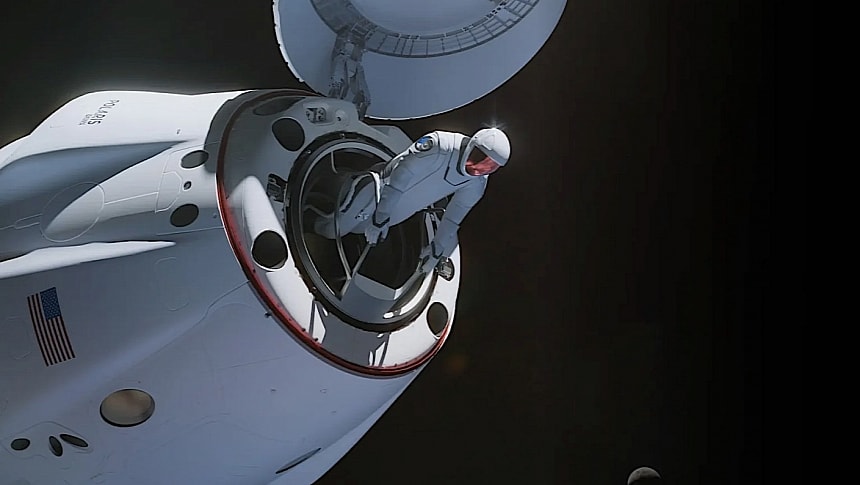In the relatively short period of time it has been on the market, Elon Musk's SpaceX has completely revolutionized space exploration. Building on older but never-accomplished dreams of reusability, the company not only managed to reignite the space race (this time between companies, not nations), but it also ushered in the era of space tourism.
There are several companies doing business in this sector at the moment, the most important of them being SpaceX, Blue Origin, and Virgin Galactic. Of the three, however, only SpaceX offers a truly otherworldly experience, as the other two only fly their customers to the edge of space for a very brief period of time.
SpaceX's first private mission was Inspiration4. Having taken off back in 2021, the mission had an all-civilian crew, the first-ever, stay in space inside the Crew Dragon spacecraft for a total of almost three days.
Not only was Inspiration4 the first all-civilian mission to space, but it also marked the moment when a human with a prosthetic leg bone departed our planet – a major reason to hope for people whose physical condition has long denied them any dreams of reaching space.
The mission was led by American billionaire entrepreneur Jared Isaacman, a man who fell in love with the darkness beyond the borders of our planet that he decided he'd do it again. And so he will, as later this year a mission called Polaris Dawn is scheduled to lift off and check a number of space exploration firsts.
Dawn is the first mission of a program called Polaris, which, at the time of writing, comprises three planned flights. It is scheduled to take off no earlier than the summer of this year using a SpaceX Falcon 9 rocket and a modified Crew Dragon spacecraft.
I say modified because this vehicle will be the first ever in the Dragon lineup to allow its occupants to step out into the vacuum of space. That's right, the mission will be a spacewalk one, and it will be the first time in the history of humankind that civilians will get to do what's known in the business as an Extravehicular Activity (EVA).
Although the extent of the changes the spaceship will suffer is not entirely known, we do know what suits the crew of four will wear for their exploits. They were presented earlier this week as an evolution of the existing SpaceX suits.
Made using new materials and fabrication processes, the scalable suits feature new joints for increased mobility and a novel-design helmet. This piece is equipped on the outside with a visor coated with copper and indium tin oxide in a bid to reduce glare, while the inside packs a heads-up display meant to show data on suit pressure, temperature, and relative humidity.
So, Polaris Dawn will not only be SpaceX's first spacewalk, but it will also be the firstsuch activity to be performed by civilians, and the first time four people will be out in space at the same time. And it will happen in the farthest orbit ever achieved.
The mission profile calls for the Crew Dragon to travel to a distance of 870 miles (1,400 km) from the surface of our world, higher than any other vehicles of its kind have ever achieved. In doing so, the crew will go deep into the Van Allen radiation belt, which is a perfect opportunity for the crew to study the effects of radiation.
About halfway to that distance, at 434 miles (700 km) away, the crew will attempt its spacewalk. Sometime during their five-day stay in space, the crew will also perform the first true test of the Starlink laser-based communications system in the big void.
The crew of the Polaris Dawn mission comprises Jared Isaacman (commander), Scott Poteet (pilot, former commander of the USAF 64th Aggressor Squadron and former Thunderbird demo team pilot), Sarah Gillis (mission specialist, Lead Space Operations Engineer at SpaceX), and Anna Menon (medical officer, Lead Space Operations Engineer at SpaceX).
The mission is perhaps the most important one SpaceX has planned for the year, and it's meant, like everything else the company does, to be one of the incipient steps to our species' expansion into the solar system.
As said, the Polaris program includes two other missions. The second one will fly at some undisclosed time in the future and follow a profile that has not yet been announced.
The final flight in the Polaris effort is perhaps the most important. That's because it is this flight that will mark the first departure of the Starship spacecraft with humans on board. Just like the spacesuit that will fly on Dawn, which is supposed to be the precursor of suits meant to support humans on the Moon and Mars, the Starship is equally important, as it, together with its descendants, will be the one to take us "by the millions," as Elon Musk hopes, to those two farway places.
SpaceX's first private mission was Inspiration4. Having taken off back in 2021, the mission had an all-civilian crew, the first-ever, stay in space inside the Crew Dragon spacecraft for a total of almost three days.
Not only was Inspiration4 the first all-civilian mission to space, but it also marked the moment when a human with a prosthetic leg bone departed our planet – a major reason to hope for people whose physical condition has long denied them any dreams of reaching space.
The mission was led by American billionaire entrepreneur Jared Isaacman, a man who fell in love with the darkness beyond the borders of our planet that he decided he'd do it again. And so he will, as later this year a mission called Polaris Dawn is scheduled to lift off and check a number of space exploration firsts.
Dawn is the first mission of a program called Polaris, which, at the time of writing, comprises three planned flights. It is scheduled to take off no earlier than the summer of this year using a SpaceX Falcon 9 rocket and a modified Crew Dragon spacecraft.
Although the extent of the changes the spaceship will suffer is not entirely known, we do know what suits the crew of four will wear for their exploits. They were presented earlier this week as an evolution of the existing SpaceX suits.
Made using new materials and fabrication processes, the scalable suits feature new joints for increased mobility and a novel-design helmet. This piece is equipped on the outside with a visor coated with copper and indium tin oxide in a bid to reduce glare, while the inside packs a heads-up display meant to show data on suit pressure, temperature, and relative humidity.
So, Polaris Dawn will not only be SpaceX's first spacewalk, but it will also be the firstsuch activity to be performed by civilians, and the first time four people will be out in space at the same time. And it will happen in the farthest orbit ever achieved.
The mission profile calls for the Crew Dragon to travel to a distance of 870 miles (1,400 km) from the surface of our world, higher than any other vehicles of its kind have ever achieved. In doing so, the crew will go deep into the Van Allen radiation belt, which is a perfect opportunity for the crew to study the effects of radiation.
About halfway to that distance, at 434 miles (700 km) away, the crew will attempt its spacewalk. Sometime during their five-day stay in space, the crew will also perform the first true test of the Starlink laser-based communications system in the big void.
The mission is perhaps the most important one SpaceX has planned for the year, and it's meant, like everything else the company does, to be one of the incipient steps to our species' expansion into the solar system.
As said, the Polaris program includes two other missions. The second one will fly at some undisclosed time in the future and follow a profile that has not yet been announced.
The final flight in the Polaris effort is perhaps the most important. That's because it is this flight that will mark the first departure of the Starship spacecraft with humans on board. Just like the spacesuit that will fly on Dawn, which is supposed to be the precursor of suits meant to support humans on the Moon and Mars, the Starship is equally important, as it, together with its descendants, will be the one to take us "by the millions," as Elon Musk hopes, to those two farway places.





















